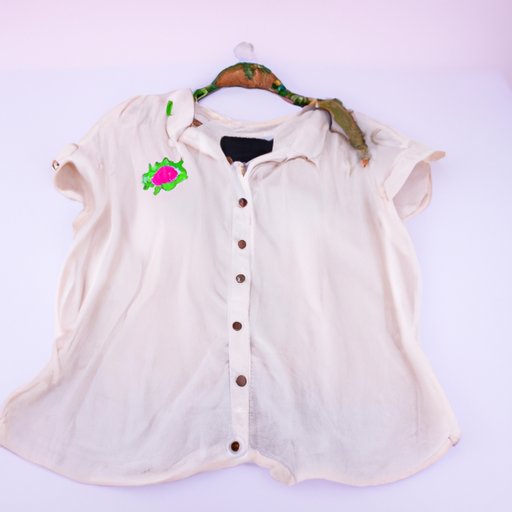
Introduction
Have you ever wanted to add a personal touch to your wardrobe or revamp an old shirt? Bleaching a shirt is an easy and inexpensive way to achieve a unique look. This article is for anyone interested in transforming their clothes and experimenting with their own personal style. Before embarking on this journey, remember that safety is key when working with bleach. It is important to follow all precautions to avoid accidents and obtain the best possible results. This comprehensive guide will take you through every step of the process, from safety precautions to incorporating your bleached creation into your wardrobe.
Step-by-Step Guide to Bleaching a Shirt
The first step in bleaching a shirt is to gather all the necessary materials. You will need a shirt, bleach, water, gloves, protective goggles, a bucket or sink, and a clothespin or hanger. Once you have all the materials, it is important to follow safety precautions to avoid any accidents. Wear gloves and protective goggles at all times to avoid contact with bleach, which can irritate your skin and eyes.
Begin by preparing the bleach solution. Follow the instructions on the bleach bottle to create the right concentration for your shirt. In general, a ratio of 1-part bleach to 10 parts water will suffice. If you want a more dramatic effect, use a higher concentration. Fill a bucket or sink with water and add the bleach solution. Mix well.
Dip the shirt into the bleach solution, making sure that it is fully immersed. Use a clothespin or hanger to hang it to dry in a well-ventilated area. Keep in mind that the bleach solution can be reused for multiple shirts but will become less potent over time.
Types of Bleach
Bleach comes in several different formulas, and it is important to choose the right one for your fabric and stain. Chlorine bleach is the most common, but it can damage some fabrics with repeated use. Oxygen bleach is a milder alternative that is safe for most fabrics and colors. Color-safe bleach can be used on colored fabrics without causing fading or discoloration.
Different types of stains require different types of bleach. Chlorine bleach is most effective for removing tough stains such as coffee, wine, and blood. Oxygen bleach is best for removing stains from grass and dirt. Color-safe bleach is great for removing stains from colored fabrics without the risk of fading or discoloration.
Each type of bleach has its pros and cons. Chlorine bleach is more powerful, but it can be damaging to some fabrics. Oxygen bleach is gentler but may require a longer soak time. Color-safe bleach is ideal for colored fabrics but may not be as effective as chlorine bleach in removing tough stains.
Stain-Specific Approach
When it comes to removing stains with bleach, it is important to use the right type of bleach for the stain. For example, chlorine bleach is effective for removing ink and grass stains, but it is not recommended for blood stains as it can set the stain permanently.
To remove ink stains, soak the stained area in a solution of equal parts water and chlorine bleach. Leave it to sit for up to 15 minutes, then rinse with cold water and repeat if necessary. For grass stains, mix one part water to three parts oxygen bleach and apply the solution to the stain. Allow it to soak for at least 30 minutes before washing. Blood stains should be soaked in cold water before applying an oxygen bleach solution and allowing it to soak for at least 30 minutes.
Natural Alternatives to Bleach
For those who prefer natural options, there are several alternatives to bleach that can be just as effective. Lemon juice, vinegar, and baking soda are all great natural alternatives. To use lemon juice, mix equal parts lemon juice and water and soak the garment for up to an hour. Vinegar can be used in the same way by diluting it with water and soaking the garment. Baking soda can be mixed with water to create a paste that can be rubbed onto stains before washing.
Risks Associated with Bleach
Despite its benefits, bleach can pose some risks. It can cause skin and eye irritation, and inhaling bleach fumes can cause respiratory problems. To minimize the risks associated with bleach, always wear gloves and protective goggles. Work in a well-ventilated area and never mix bleach with other cleaning agents. If an accident occurs, such as bleach getting into your eyes, rinse your eyes with water for several minutes and seek medical attention if necessary.
Incorporating Bleached Clothing into Your Wardrobe
Bleached clothing has become a popular fashion trend, and there are many ways to incorporate it into your wardrobe. A bleached t-shirt can be worn with jeans for a casual look or dressed up with a blazer. A bleached denim shirt can be paired with shorts and sneakers for a summer look. To add a personal touch, try customizing your bleached shirt by adding fabric paint or stitching.
Conclusion
Bleaching a shirt is an easy and affordable way to add a unique touch to your wardrobe. By following the safety precautions and using the right type of bleach, you can achieve the perfect look without any mishaps. With the tips provided in this guide, you can experiment with your own personal style and create a fashion statement that is all your own.





